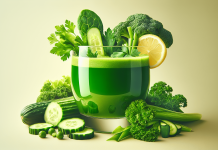Are you looking for a delicious and healthy way to shed some extra pounds? Look no further! In this article, you will find a collection of low-calorie juice recipes that are not only incredibly tasty but also specifically designed to help you achieve your weight loss goals. Say goodbye to boring and bland diet drinks, because with these refreshing and nutrient-packed recipes, you can sip your way to a slimmer and healthier you. Get ready to discover the incredible flavors and benefits of these low-calorie juice recipes for weight loss. It’s time to take control of your health and enjoy every sip along the way!
Review contents
I. Juice Recipes
A. Green Juice
Green juice is a fantastic way to kickstart your day and boost your health. Packed with nutrient-rich leafy greens such as spinach and kale, this juice recipe provides a refreshing and energizing start to your morning routine. You can also add other green vegetables like cucumber and celery for added hydration and cleansing properties. Green juice is not only low in calories but also high in fiber, which aids digestion and promotes a feeling of fullness.
B. Citrus Juice
If you’re looking for a burst of tangy flavor, citrus juice is the perfect choice. From oranges and grapefruits to lemons and limes, citrus fruits are known for their high vitamin C content and refreshing taste. Citrus juice is low in calories and provides a natural energy boost, making it an excellent choice for a midday pick-me-up. Additionally, the antioxidants found in citrus fruits offer numerous health benefits, including immune support and improved skin health.
C. Berry Juice
Berries are not only delicious but also packed with essential vitamins, minerals, and antioxidants. From strawberries and blueberries to raspberries and blackberries, these vibrant fruits make for an invigorating and low-calorie juice. Berry juice is not only rich in flavor but also provides a variety of health benefits, including improved heart health and enhanced brain function. The natural sweetness of berries also helps satisfy your sweet cravings without the added calories.
D. Veggie Juice
Vegetable juice is a fantastic way to incorporate more greens into your diet. By combining vegetables like carrots, beets, and bell peppers, you can create a nutrient-dense and low-calorie juice. Veggie juice is rich in antioxidants, vitamins, and minerals, which support overall health and wellbeing. It is also an excellent option for those seeking a savory and refreshing juice alternative.
E. Tropical Juice
Transport yourself to a tropical paradise with a refreshing tropical juice blend. Combining fruits like pineapple, mango, and papaya, this juice recipe is a perfect balance of sweetness and tanginess. Tropical fruits are not only low in calories but also packed with essential vitamins and minerals. This juice can also help boost your immune system and provide a much-needed burst of energy on a hot summer day.
II. Benefits of Low-Calorie Juice
A. Weight Loss
Low-calorie juice is often the go-to choice for individuals looking to shed some pounds while still enjoying delicious drinks. By opting for low-calorie juice, you can reduce your overall calorie intake, creating a calorie deficit necessary for weight loss. Additionally, the high fiber content found in many low-calorie juice recipes promotes a feeling of fullness and reduces the likelihood of overeating.
B. Hydration
Staying hydrated is essential for overall health and wellbeing. Low-calorie juices, which are often packed with water-rich fruits and vegetables, can help you meet your daily hydration goals. Incorporating these juices into your routine ensures that you stay properly hydrated, supporting various bodily functions such as digestion, temperature regulation, and nutrient delivery.
C. Nutritional Value
While low in calories, many juice recipes are packed with essential vitamins, minerals, and antioxidants. By consuming these nutrient-dense juices, you provide your body with the necessary tools to support optimal health. Whether it’s vitamin C from citrus juice or fiber from green juice, low-calorie juices can contribute to a well-rounded and balanced diet.
D. Detoxification
Low-calorie juice recipes are often associated with detoxification due to the presence of various fruits and vegetables known for their cleansing properties. Ingredients like beets, celery, and lemon can help promote liver health and aid in the removal of toxins from the body. Including these juices in your routine can support the body’s natural detoxification processes and leave you feeling rejuvenated.
III. Factors to Consider
A. Fruit and Vegetable Selection
When choosing fruits and vegetables for your low-calorie juices, it’s important to opt for those that are low in calories and sugar. Leafy greens, citrus fruits, berries, and vegetables like cucumber and celery are excellent choices due to their low calorie and sugar content. By selecting the right ingredients, you can ensure that your juice remains low in calories while providing optimal nutrition.
B. Calorie Count
It’s important to keep track of the calorie content of your juice recipes, especially if you are consuming them as part of a weight loss plan. To keep the calorie count low, focus on using mostly low-calorie ingredients and avoid high-calorie additions like sweeteners or excessive amounts of high-sugar fruits. Paying attention to portion sizes can also help control your calorie intake.
C. Portion Size
While low-calorie juices can be a great addition to your diet, it’s important to drink them in moderation. Portion control is key when it comes to maintaining a balanced diet and avoiding overconsumption of calories. Stick to recommended serving sizes and consider enjoying your juice as a snack or a small meal replacement rather than a beverage accompanying a larger meal.
D. Juice Quality
To ensure that you are reaping the full benefits of low-calorie juice, it’s crucial to prioritize quality ingredients. Whenever possible, opt for organic fruits and vegetables to minimize exposure to pesticides and maximize the nutritional value of your juice. Freshly squeezed juice is also preferred over store-bought options, as it retains more nutrients and tastes fresher.
IV. Tips and Tricks
A. Add Herbs and Spices
Enhance the flavor and nutritional profile of your low-calorie juice by adding herbs and spices. Fresh mint, basil, ginger, and turmeric can provide an extra kick of flavor and offer various health benefits. Experiment with different combinations to find your favorite herb and spice pairings.
B. Use Natural Sweeteners
If you prefer a sweeter juice but want to keep the calorie count low, opt for natural sweeteners like honey, agave syrup, or stevia instead of refined sugar. These sweeteners add a touch of sweetness without the additional calories, making them ideal for those watching their sugar intake.
C. Incorporate Protein
To make your low-calorie juice more satisfying and nourishing, consider adding a source of protein. Greek yogurt, nut butter, or plant-based protein powders can help increase the protein content, which promotes satiety and muscle recovery. Adding protein also makes your juice a well-rounded snack or meal replacement.
D. Experiment with Combinations
Don’t be afraid to get creative and try out different combinations of fruits, vegetables, and herbs. Mixing flavors and textures can result in unique and delicious low-calorie juices. Whether it’s a savory vegetable blend or a sweet and tangy fruit medley, the possibilities are endless.
V. Precautions
A. Allergies and Sensitivities
Before diving into low-calorie juice recipes, it’s essential to consider any allergies or sensitivities you may have. Certain fruits, vegetables, and herbs can trigger allergic reactions or digestive issues in some individuals. Be mindful of potential allergens and consult with a healthcare professional if you have any concerns.
B. Balanced Diet
While low-calorie juices can be a beneficial addition to a healthy diet, they should not replace whole foods entirely. It’s important to maintain a balanced diet that includes a variety of fruits, vegetables, whole grains, lean proteins, and healthy fats. Low-calorie juices should complement your overall dietary intake rather than serve as a substitute for nourishing meals.
C. Limiting Added Sugar
Although low-calorie juice options are naturally low in sugar, it’s important to avoid excessive use of added sugars. Be cautious when including sweeteners in your juices and remember that moderation is key. Overconsumption of added sugars can contribute to weight gain, inflammation, and other health issues.
D. Consultation with a Nutritionist
If you have specific health concerns, dietary restrictions, or are unsure about incorporating low-calorie juices into your routine, it’s always a good idea to consult with a registered nutritionist or healthcare professional. They can provide personalized advice, guidance, and ensure that your juice consumption aligns with your individual needs and goals.
VI. Conclusion
Low-calorie juice recipes offer a delicious and refreshing way to support weight loss, hydration, and overall health. Whether you prefer the vibrant flavors of green juice or the tanginess of citrus juice, there is a low-calorie option to satisfy every palate. By considering factors such as fruit and vegetable selection, portion sizes, and juice quality, you can maximize the benefits of these nutrient-dense beverages. Remember to experiment with herbs, spices, and natural sweeteners to enhance the flavors and consider consulting with a nutritionist to ensure that your juice consumption aligns with your individual needs. Cheers to a healthier and more vibrant you!

































